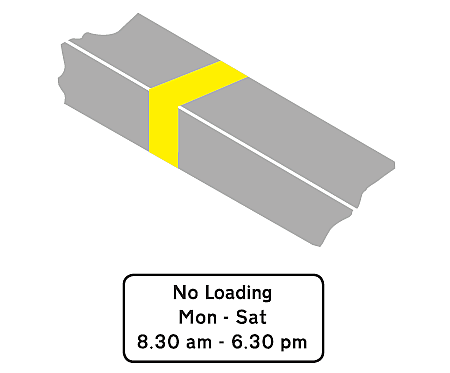- What is loading?
- Always remember
- Yellow lines
- Red lines
- Clearways
- Parking bays
- Avoiding Penalty Charge Notices (PCNs)
- If you get a PCN
What is loading?
Loading and unloading is permitted on single and double yellow lines for a maximum of 40 minutes if loading is observed. You must not cause an obstruction and ensure that there is no loading ban
Where there is a loading ban, in addition to parking restrictions, you will see yellow stripes (chevrons) on the kerb. Double stripes are indicate that loading and unloading is not permitted AT ANY TIME and will have an accompanying timeplate. Single stripes mean no loading and unloading during certain times and will also have an accompanying time plate (see example below).
All commercial deliveries and collections (including multi-drop and couriers) are included in the exemption. Reasonable time is allowed for the checking of paperwork too – however, as soon as the delivery has finished the vehicle must be moved.
Builders dropping off or picking up tools from a site are exempt, but the vehicle must be removed immediately the loading and unloading has been completed. If it is essential for a vehicle to be parked nearby while working (e.g. a glazier’s or scaffolder’s vehicle) then you should contact the council to make special arrangements.
Loading time is restricted to either 20 or 40 minutes depending upon the location. If more time is required contact the council for permission (a dispensation) in advance.
Always remember
Many, but not all, parking restrictions allow an exemption for loading. But, wherever you are you should:
- never stop where your vehicle will cause an obstruction to traffic or pedestrians
- never stop on white zig-zags at pedestrian crossings
- never stop on restricted areas outside schools when prohibited
- only park on the pavement if there is no other way the delivery or collection could be made and if someone is left with the vehicle at all times.
Yellow lines
- loading and unloading is permitted on single and double yellow lines for a maximum of 40 minutes if loading is observed. You must not cause an obstruction and ensure that there is no loading ban

Red lines
- you cannot stop to load and unload on a red line during its operational times. Double red lines apply all day, most single red lines apply between 7am and 7pm but are signed
- red routes have red loading ‘boxes’ marked on the road where loading is permitted at certain times.
Always check the permitted loading times on the sign.
Clearways
![]()
- on clearways stopping to load and unload is banned
- bus stops and taxi ranks are often clearways. You should not load and unload on a restricted bus stop or stand or on a taxi rank.
Parking bays
- you can stop to load and unload on parking bays (pay and display, residents’ bays etc.) for a maximum of 20 minutes during controlled hours
- you cannot load and unload on diplomatic parking bays
- you cannot load and unload on a suspended parking bay (unless you have requested the suspension)
- you should if possible avoid using disabled bays.
Avoiding Penalty Charge Notices (PCNs)
You should:
- check the signs and lines to ensure loading and unloading is permitted before you start
- tell any traffic warden or civil enforcement officer that you are loading and that you will move the vehicle once you are finished
- if you are leaving the vehicle unattended try to make it obvious that you are loading and loading.
If you get a PCN
You should:
- not ignore PCNs – penalties can escalate if you do not pay or challenge promptly
- not argue with the traffic warden or civil enforcement officer after a PCN has been issued; they cannot and will not cancel it
- move the vehicle, if you do not it may be clamped or towed away
- pay promptly if you were in the wrong; this will save you time and inconvenience
- if you see the traffic warden or civil enforcement officer ask them to make a note of the fact that you were loading in their pocket book; this might help you challenge the PCN later
- if you have been away from the vehicle loading and return to find a PCN, you should be prepared to explain (to the council or adjudicator) exactly what you were doing
- keep copies of documentary evidence (for example, delivery notes and receipts).
